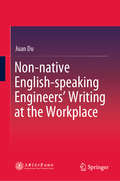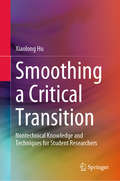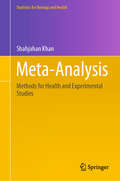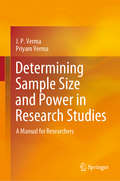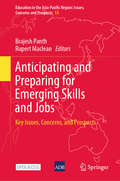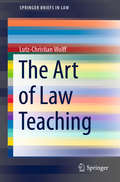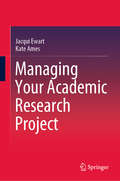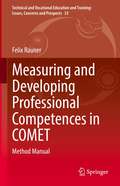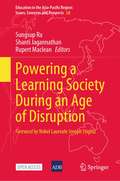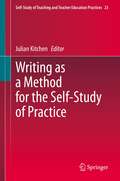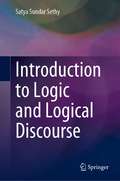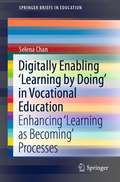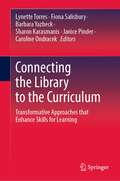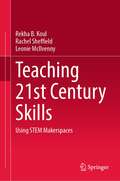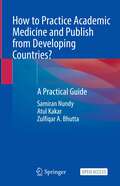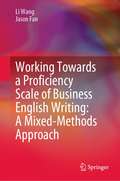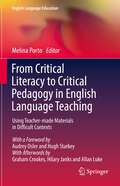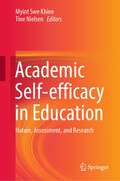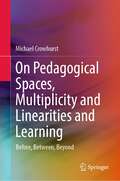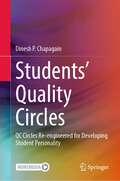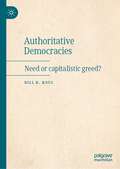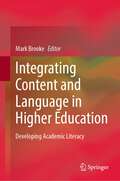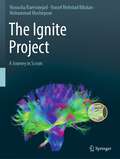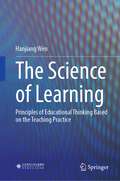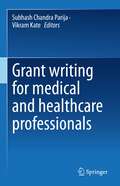- Table View
- List View
Non-native English-speaking Engineers’ Writing at the Workplace
by Juan DuBased on 55 semi-structured in-depth interviews, this book investigates 15 high-tech engineering co-op professionals’ writing experience in the workplace. It shows how the digital age has had a marked impact on the engineers’ methods of communication at work, and how on-the -job writing has affected engineers’ technical competence, shaped their professional identities, challenged their views on Chinese and English writing, and hindered their success in the workplace. The book identifies three aspects of writing practice: engineers’ linguistic and literacy challenges, the reasons behind these challenges, and coping strategies, which suggest that engineers are underprepared and lack necessary support in the workplace. Lastly, the study shows that engineers need to engage in technical literacy through on-the-job writing so that they can fully deal with workplace discourse and socialize with diverse professional groups.Since the sample group interviewed in this book is engineers who studied at universities in the United States and have a foot in the world of school and work as well as knowledge of both Eastern and Western cultures, the book appeals to teachers, students, engineers and scientists who are interested in scientific and technological writing. It is also valuable for educators who prepare scientists, engineers, and technical communicators for professional roles, as well as for communication practitioners who work with engineers.
Smoothing a Critical Transition: Nontechnical Knowledge and Techniques for Student Researchers
by Xiaolong HuThis textbook equips students interested in becoming researchers with the essential nontechnical skills. After an introduction to graduate schools, it discusses preparing for research, reading and organizing literature, writing research articles and other documents, publishing papers, presenting research findings at conferences, collaboration with advisors and other researchers, patent applications, research ethics, and how to improve research by learning about the history of science. These nontechnical skills are just as important as technical ones in terms of becoming a successful graduate student, yet they have seldom been taught systematically in courses. Further, they can bridge the gap from the classroom to the lab, making one of the most critical transition periods—from student to researcher—smoother and more enjoyable. The book features a wealth of real-life examples and exercises, which readers can easily apply in their own research. Intended mainly for graduate and upper-undergraduate students just embarking on lab research, it can also be used as a textbook or reference guide for courses on research methodology and related topics.
Meta-Analysis: Methods for Health and Experimental Studies (Statistics for Biology and Health)
by Shahjahan KhanThis book focuses on performing hands-on meta-analysis using MetaXL, a free add-on to MS Excel. The illustrative examples are taken mainly from medical and health sciences studies, but the generic methods can be used to perform meta-analysis on data from any other discipline. The book adopts a step-by-step approach to perform meta-analyses and interpret the results. Stata codes for meta-analyses are also provided. All popularly used meta-analytic methods and models – such as the fixed effect model, random effects model, inverse variance heterogeneity model, and quality effect model – are used to find the confidence interval for the effect size measure of independent primary studies and the pooled study. In addition to the commonly used meta-analytic methods for various effect size measures, the book includes special topics such as meta-regression, dose-response meta-analysis, and publication bias. The main attraction for readers is the book’s simplicity and straightforwardness in conducting actual meta-analysis using MetaXL. Researchers would easily find everything on meta-analysis of any particular effect size in one specific chapter once they could determine the underlying effect measure. Readers will be able to see the results under different models and also will be able to select the correct model to obtain accurate results.
Determining Sample Size and Power in Research Studies: A Manual for Researchers
by J. P. Verma Priyam VermaThis book addresses sample size and power in the context of research, offering valuable insights for graduate and doctoral students as well as researchers in any discipline where data is generated to investigate research questions. It explains how to enhance the authenticity of research by estimating the sample size and reporting the power of the tests used. Further, it discusses the issue of sample size determination in survey studies as well as in hypothesis testing experiments so that readers can grasp the concept of statistical errors, minimum detectable difference, effect size, one-tail and two-tail tests and the power of the test. The book also highlights the importance of fixing these boundary conditions in enhancing the authenticity of research findings and improving the chances of research papers being accepted by respected journals. Further, it explores the significance of sample size by showing the power achieved in selected doctoral studies. Procedure has been discussed to fix power in the hypothesis testing experiment. One should usually have power at least 0.8 in the study because having power less than this will have the issue of practical significance of findings. If the power in any study is less than 0.5 then it would be better to test the hypothesis by tossing a coin instead of organizing the experiment. It also discusses determining sample size and power using the freeware G*Power software, based on twenty-one examples using different analyses, like t-test, parametric and non-parametric correlations, multivariate regression, logistic regression, independent and repeated measures ANOVA, mixed design, MANOVA and chi-square.
Anticipating and Preparing for Emerging Skills and Jobs: Key Issues, Concerns, and Prospects (Education in the Asia-Pacific Region: Issues, Concerns and Prospects #55)
by Brajesh Panth Rupert MacleanThis open access book analyzes the main drivers that are influencing the dramatic evolution of work in Asia and the Pacific and identifies the implications for education and training in the region. It also assesses how education and training philosophies, curricula, and pedagogy can be reshaped to produce workers with the skills required to meet the emerging demands of the Fourth Industrial Revolution.The book’s 40 articles cover a wide range of topics and reflect the diverse perspectives of the eminent policy makers, practitioners, and researchers who authored them. To maximize its potential impact, this Springer-Asian Development Bank co-publication has been made available as open access.
The Art of Law Teaching (SpringerBriefs in Law)
by Lutz-Christian WolffWritten by an award-winning professor with over 25 years of experience, this book explains comprehensively the different facets of law teaching from the law teacher’s perspective. It uniquely covers numerous topics which have been ignored by the legal education literature so far, but which are of immense importance for the success of law students, law schools and—last but not least—the day-to-day work of law teachers themselves. These topics include the goals of law teaching, the factors that lead to successful law teaching, special characteristics of good law teachers, different ways of preparing for in-class success, face-to-face versus online teaching, the in-class teaching experience, assessments, teaching evaluations, the design of new courses and programmes, the teacher–student and the teacher–teacher relationship, the importance of teaching administration as well as the future of law teaching in the digital age. The author approaches various themes from the viewpoint of his own experience. He tells his very personal stories of classroom success and failure, of enthusiasm, fun and disappointments when dealing with law students, of accomplishments and frustrations when considering learning outcomes and of surprises when dealing with red tape. He thus allows the readership to grasp different aspects of law teaching in a very hands-own way and facilitates the understanding of the underlying often rather complex human-to-human relationships. This book should be in the bookshelf of any law teacher. As it covers a wide spectrum of so far unexplored legal education issues, it is also an invaluable source at the start of a law teaching career, but also for established law teachers who wish to reflect on their own teaching approaches. A rich body of cross-references to the existing literature makes the book a powerful tool for research on any aspect of legal education. Last but not least, the author’s ironic sense of himself and of the law teacher profession makes the book a very entertaining read for anybody who always wanted to know what law teaching really is (and is not) about.
Managing Your Academic Research Project
by Jacqui Ewart Kate AmesThis book is an essential resource for academics managing a large and complex research project. It provides important practical insights into the processes that inform such research projects and delivers insights into the delicate balance between industry, stakeholder and academic needs. It gives practical advice about developing relationships with diverse partners and colleagues and managing the expectations of the various parties involved and on avoiding pitfalls. This book uses examples from Australian research projects, but it contains insights relevant to researchers all around the world.
Measuring and Developing Professional Competences in COMET: Method Manual (Technical and Vocational Education and Training: Issues, Concerns and Prospects #33)
by Felix RaunerThis book is a detailed manual for the implementation of competence diagnostics in the field of vocational training. With the COMET competence model, both conceptual competences as well as practical skills are recorded and evaluated. The manual guides through all methodological steps, including the preparation and implementation of tests, cross and longitudinal studies, the development of context analyses and measurement methods for the test motivation. The focus of the final chapter is the application of the COMET procedure for the design, organisation and evaluation of vocational education and training processes.
Powering a Learning Society During an Age of Disruption (Education in the Asia-Pacific Region: Issues, Concerns and Prospects #58)
by Rupert Maclean Shanti Jagannathan Sungsup RaThis open access book presents contemporary perspectives on the role of a learning society from the lens of leading practitioners, experts from universities, governments, and industry leaders. The think pieces argue for a learning society as a major driver of change with far-reaching influence on learning to serve the needs of economies and societies. The book is a testimonial to the importance of ‘learning communities.’ It highlights the pivotal role that can be played by non-traditional actors such as city and urban planners, citizens, transport professionals, and technology companies. This collection seeks to contribute to the discourse on strengthening the fabric of a learning society crucial for future economic and social development, particularly in the aftermath of the coronavirus disease.
Writing as a Method for the Self-Study of Practice (Self-Study of Teaching and Teacher Education Practices #23)
by Julian KitchenThis book focuses on the writing process in the self-study of teaching and teacher education practices. It addresses writing as an area in which teacher educators can develop their skills and represents how to write in ways that are compatible with self-study's orientations towards the inquiry, both personal and on practice. The book examines effective self-study writing with chapters written by experienced self-study practitioners. In addition to considering elements of writing as a method for the self-study of practice, it delves into the cognitive processes of real writers making explicit their writing practices. Practical suggestions are connected to the lived experiences of self-study practitioners making sense of their field through the process of writing. This book will be of interest to doctoral and novice self-study writers, and experienced authors seeking to develop their practice. It demonstrates that writing as a method of inquiry in self-study and beyond can be learned, modeled and taught.
Introduction to Logic and Logical Discourse
by Satya Sundar SethyThis book focuses on logic and logical language. It examines different types of words, terms and propositions in detail. While discussing the nature of propositions, it illustrates the procedures used to determine the truth and falsity of a proposition, and the validity and invalidity of an argument. In addition, the book provides a clear exposition of the pure and mixed form of syllogism with suitable examples. The book encompasses sentential logic, predicate logic, symbolic logic, induction and set theory topics. The book is designed to serve all those involved in teaching and learning courses on logic. It offers a valuable resource for students and researchers in philosophy, mathematics and computer science disciplines. Given its scope, it is an essential read for everyone interested in logic, language, formulation of the hypotheses for the scientific enquiries and research studies, and judging valid and invalid arguments in the natural language discourse.
Digitally Enabling 'Learning by Doing' in Vocational Education: Enhancing ‘Learning as Becoming’ Processes (SpringerBriefs in Education)
by Selena ChanThis book introduces, rationalizes and describes some ways to circumvent the challenges of providing ‘hands-on’ learning when programmes with practice-based focuses have to be offered via distance learning. It presents a framework to help deconstruct the many aspects of ‘learning to become’ a professional or practitioner. Then, it demarcates the skills, knowledge and attributes towards ensuring learners are prepared for the exigencies of the future of work. The book details the types of pedagogical approaches, including project/inquiry/problem-based learning, which help assist learners to learn both the competencies and capabilities required. It introduces technology-enhanced learning (TEL) platforms and tools supporting ‘education 4.0’, and presents a series of contemporary research studies on the integration of TEL, which are augmented and updated to allow for the challenges of provisioning opportunities for ‘learning by doing’ through distance learning. Finally, the book proposes recommendations to help ensure that institutions are better prepared for the sustainable shift to distance learning.
Connecting the Library to the Curriculum: Transformative Approaches that Enhance Skills for Learning
by Lynette Torres Fiona Salisbury Barbara Yazbeck Sharon Karasmanis Janice Pinder Caroline OndracekThis book shares the experiences of the Monash University and La Trobe University libraries in Melbourne, Australia, regarding the paths taken to transform and reposition these libraries within their institutions. The book showcases the respective frameworks used to enhance library skill development programs and addresses central topics such as partnerships, pedagogy, curriculum, emerging skill agendas and student success. It offers a theoretical and practical approach to overcoming persistent challenges and discusses several pertinent areas, e.g., establishing library-faculty partnerships, explicitly and coherently developing students’ research skills with discipline-specific content and transforming perceptions of academic libraries’ educative role. The book highlights the current issue of enhancing students’ research skills, which is forcing many academic libraries to reassess their established practices and adopt pedagogical approaches that will more readily resonate with faculty.Chapters 3 and 19 are available open access under a Creative Commons Attribution 4.0 International License via link.springer.com.
Teaching 21st Century Skills: Using STEM Makerspaces
by Rekha B. Koul Rachel Sheffield Leonie McIlvennyThis book helps educators provide opportunities for their students to engage in creative and collaborative projects that blur the lines between subjects and promote problem-finding and problem-solving activities. It offers a global perspective on makerspaces through an Indian and Australian lens, illustrating the commonalities between the approach and the pedagogy in order to highlight the universal nature of these essential 21st-century skills. The book is particularly useful for science, technology and mathematics teachers, highlighting the potential of engaging in a more integrated curriculum approach to their specific discipline. It is of great interest to scholars whose research focuses on understanding 21st-century skills and how they can be taught and assessed in a school setting. It is an indispensable resource for teacher educators, school administrators, curriculum designers, policymakers and researchers in the field of science education.
How to Practice Academic Medicine and Publish from Developing Countries?: A Practical Guide
by Samiran Nundy Atul Kakar Zulfiqar A. BhuttaThis is an open access book. The book provides an overview of the state of research in developing countries – Africa, Latin America, and Asia (especially India) and why research and publications are important in these regions. It addresses budding but struggling academics in low and middle-income countries. It is written mainly by senior colleagues who have experienced and recognized the challenges with design, documentation, and publication of health research in the developing world. The book includes short chapters providing insight into planning research at the undergraduate or postgraduate level, issues related to research ethics, and conduct of clinical trials. It also serves as a guide towards establishing a research question and research methodology. It covers important concepts such as writing a paper, the submission process, dealing with rejection and revisions, and covers additional topics such as planning lectures and presentations. The book will be useful for graduates, postgraduates, teachers as well as physicians and practitioners all over the developing world who are interested in academic medicine and wish to do medical research.
Working Towards a Proficiency Scale of Business English Writing: A Mixed-Methods Approach
by Li Wang Jason FanThis book presents an empirical study to develop and validate a proficiency scale of business English writing in the Chinese tertiary context. Through a mixture of intuitive, quantitative and qualitative methods, the book demonstrates how a pool of descriptors are collectively formulated, statistically calibrated and meticulously validated for the establishment of a proficiency scale of business English writing. The writing scale differs in significant ways from the existing language scales, most of which were constructed in English as L1 or L2 contexts and applied to English for General Purposes (EGP) domains. This book also provides important insights into the construct of business English writing as well as the methods for English for Specific Purposes (ESP) proficiency scale development and validation. It is of particular interest to those who work in the area of ESP teaching and assessment.
From Critical Literacy to Critical Pedagogy in English Language Teaching: Using Teacher-made Materials in Difficult Contexts (English Language Education #23)
by Melina PortoWith a Foreword by Hugh Starkey and Audrey Osler, and Afterwords by Graham Crookes, Hilary Janks and Allan Luke, this book promotes critical language education and illustrates how a critical agenda can be enacted in English language education in real classrooms. It presents four cases located in primary and secondary schools in the province of Buenos Aires in Argentina in contexts that can be characterised as vulnerable or difficult. It describes the possibilities, challenges and limitations of this critical agenda using students’ drawings, posters, leaflets, artwork, classroom activities and conversational data as foundation, and including the voices of local teachers in their classrooms. Importantly, these teachers used teacher-made, locally produced, critical post-method materials, described by the author of those materials in one of the chapters. In this way, the book offers a unique balance of researcher, teacher and materials writer voices. These materials are included in the book and can help language teachers around the world to introduce critical perspectives in their specific contexts. The book is appealing to researchers, classroom teachers, teacher educators, and materials writers and developers interested in critical language education.
Academic Self-efficacy in Education: Nature, Assessment, and Research
by Myint Swe Khine Tine NielsenThis book documents systematic, prodigious and multidisciplinary research in the nature and role of academic self-efficacy, and identifies areas for future research directions within the three sections of the book: 'Assessment and Measurement of Academic Self-efficacy', 'Empirical Studies on What Shapes Academic Self-efficacy', and 'Empirical Studies on Influence of Academic Self-efficacy'. The book presents works by educators and researchers in the field from various parts of the world, highlighting advances, creative and unique approaches, and innovative methods. It examines discussions around the theoretical and practical aspects of academic self-efficacy in culturally and linguistically-diverse educational contexts. This book also showcases work based on classical and modern test theory methods, mediation and moderation analysis, multi-level modelling approaches, and qualitative analyses.
On Pedagogical Spaces, Multiplicity and Linearities and Learning: Before, Between, Beyond
by Michael CrowhurstThis book introduces a research method called ‘auto-teach(er)/ing-focused research,’ a research process that aims to document understandings generated by, and for the teacher when that teacher teaches or re-teaches a course. It demonstrates how this method is applied by the author/researcher within the pedagogical space that is the teaching of a course, one that has been taught numerous times by the author/researcher over many years. This book documents understandings about learning and teaching that have emerged within the pedagogical space that is the teaching of a course, and the pedagogical space that is the writing of a book. It explores the notion that pedagogical spaces are complex, and that subjects navigate and are produced within them in a multiplicity of ways. This book applies a research method that generates a knowledge product that research practitioners in a variety of settings might find useful to adopt or adapt.
Students’ Quality Circles: QC Circles Re-engineered for Developing Student Personality
by Dinesh P. ChapagainThis book explains what Students' Quality Circles (SQC) are, how they function, key constraints and issues in implementation, and possible solutions to make it a valuable co-curricular activity. It showcases how Quality Control Circle (QCC) is reengineered with the sole purpose of prosocial personality development of students at their early age. It is a research outcome which depicts the direction of the education system toward character building rather than only developing knowledge and skills. The logical sequence of presentation of the book is ‘why,’ ‘what,’ and toward the end, ‘how’ SQC in education. The book satisfies four hierarchical levels of readers. The first level is of educationists and national policy makers who may take up SQC as an important approach of the education system in their country for prosocial personality development of students and thereby targeting to produce quality citizens in the future. At the second level are chief executives or managers of educational institutes who may identify the potential of SQC approach for developing the positive personality of their students. Teachers and SQC facilitators are at the third level, and they can use the book to train and educate their students while initiating and promoting SQC activities at their institutes. And finally, at the fourth level obviously are students who may refer to this book from time to time and practice SQC on their own for self-development and empowerment.
Authoritative Democracies: Need or capitalistic greed?
by Bill K. KoulThis book comments on growing authoritarianism in democracy and suggests how it ought to be instead. It asks if some degree of authoritarianism is the need of the hour to address potentially existential issues facing the human race. Readers are encouraged to analyse the state of democracy in their own countries and verify if it meets their expectations, or if it is just a myth or an imposter, or a necessary but imperfect compulsion in the absence of a perfect alternative. The book presents a commentary on the state of democracy in some of the world’s leading democracies. It aims to challenge the human mind, which seems to be getting accustomed to not having to think, thanks to a constant bombardment of information—real and fake and in-between—that it receives through social and print media, which is freely accessible through smartphone to which it has become addicted. It discusses how the drivers of capitalism – through their business-like connections with powerful and influential politicians and celebrities—could be cleverly manipulating the gullible human mind and exploiting the system to their own material benefit.
Integrating Content and Language in Higher Education: Developing Academic Literacy
by Mark BrookeThis book presents research initiatives by tutors involved in a content-based instruction context as part of the University Town writing programme, National University of Singapore, which is an interdisciplinary programme designed to teach first- and second-year undergraduate students how to conduct academic research and write evidence-based research papers. It presents research the tutors conducted within the dual fields of teaching discipline-specific content and developing students’ academic literacy. The book focuses mainly on pedagogy and material development in this context. It shares the tutors' scholarship of teaching and learning experiences from this programme through presenting action research from the classroom, demonstrating constructive cycles of praxis, which are then evaluated using student texts and student feedback. The book draws on academic research literature related to content-based instruction, as well as topics such as facilitating collaborative peer reviews of assignments, and critical thinking pedagogy. It covers how multi-disciplinary or multi-lingual classrooms of this genre can motivate students to conduct and write up research and provides an overview of how both content and academic literacy is combined at a high level of engagement from an Asian context.
The Ignite Project: A Journey in Scrum
by Niyousha Raeesinejad Yousef Mehrdad Bibalan Mohammad MoshirpourThis guidebook highlights the process of a software internship project facilitated by the Schulich School of Engineering. The Scrum Team is comprised of student developers pursuing either a master’s or bachelor’s degree in Software Engineering with their professor as the stakeholder, a consulting tech company serving as the product owner, and a graduate student and seasoned industry expert as project leads. The story of this software development process is communicated through the perspectives of an observing undergraduate SE student and the team, mainly through meetings, interviews, and journal entries. This guidebook is for readers in research, education, and industry who will not only experience the same process from different angles, but they will gain insight into fundamental elements of the Scrum Framework applied in organizational projects.
The Science of Learning: Principles of Educational Thinking Based on the Teaching Practice
by Hanjiang WenThis book systematically summarizes the author's more than 30 years of experience in teaching reform and educational research. The book is divided into three parts. Part I focuses on the comprehensiveness of thinking and the relationship between the coordinated development of thinking and the overall development of human beings. Part II and Part III mainly discuss the six basic principles of learning and thinking: the principle of the working memory of thinking, the principle of learning transfer, the principle of the basic process of learning, the principle of multi-level development of ability, the principle of sustainable development of learning, and the principle of subjectivity of learning.This book features the rules and characteristics of student learning with a student-centered approach, which can help teachers and educational researchers to better understand students and provide theoretical guidance for students’ all-round development.
Grant writing for medical and healthcare professionals
by Subhash Chandra Parija Vikram KateConducting research requires resources to meet the research need. The resources in the research institutes/ centers are often inadequate, limiting the research outcome. Research grants help overcome those limitations and help the researchers carry out quality research without any restriction. Grant proposal writing is an essential skill to be mastered by every researcher. However, the majority of the medical schools, except the few research institutes, do not have a structured learning module for obtaining grants. On most occasions, the skill of writing grant proposals goes by self-learning. For students, it is burdening due to the tremendous time consumed to learn the craft of writing the grant proposal and the exhausting clinical and academic work. This book is carefully prepared to keep in mind the difficulties faced by the young researchers and the students concerning choosing a funding agency, grant makers' expectations, budgeting, surveillance and site visits, rights of the researcher and the funding agency, and ethical and legal aspects of obtaining the grant. The book also covers the alternate plan for partial funding or interruption of the financing, reporting the source of funding and acknowledgment, good clinical practice guidelines, and dealing with the rejected grant proposal. The research projects are often dropped or modified extensively due to the limited resources in the existing facility. The researchers are forced to compromise the research objective due to expensive requirements. There is a shortage of awareness regarding the availability of funding and grant for the conduct of research. Even if the researchers are aware of obtaining the financing, there is a lack of training in grant proposal writing, which is essential in getting the research funding. This book on grant proposal writing for medical and healthcare professionals covers such difficulties and deficiencies. It will provide complete companionship from knowing the funding agency to obtaining the grant.
